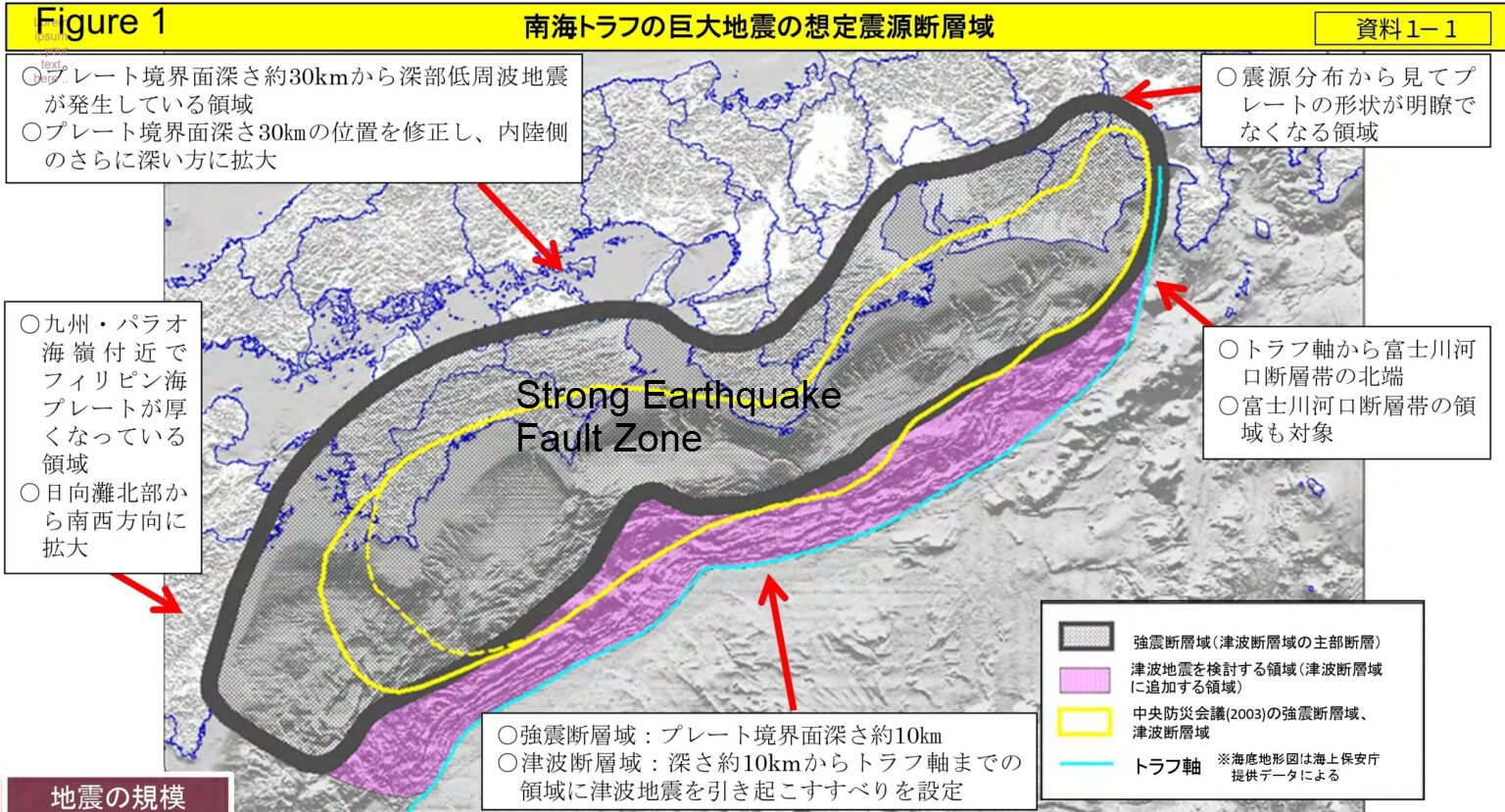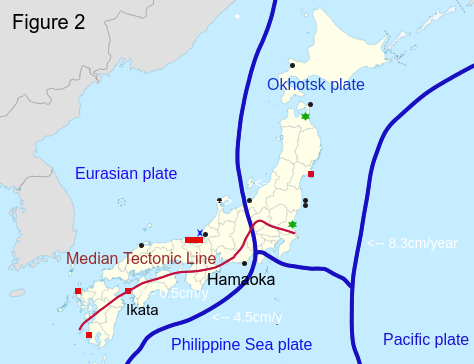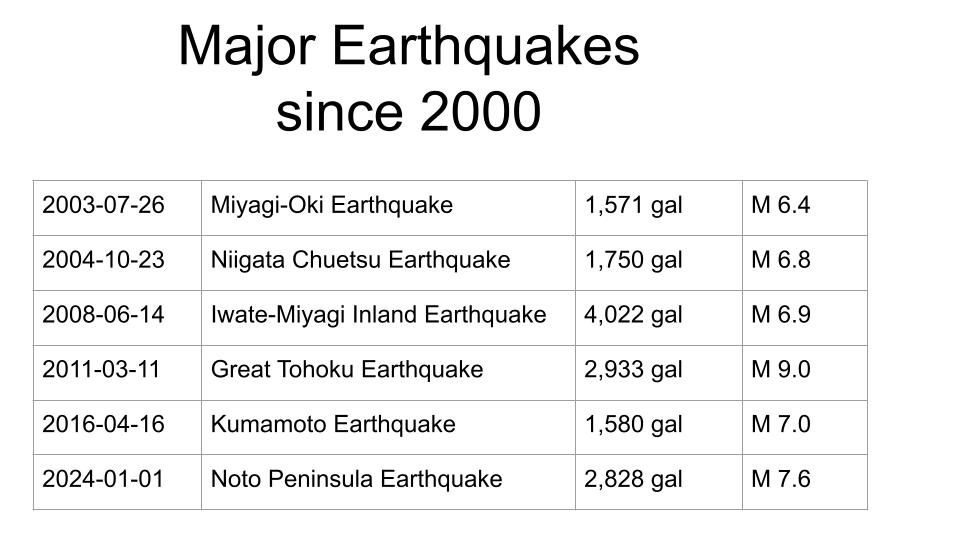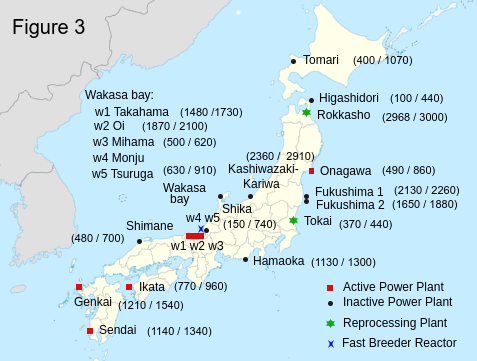Nuclear Crisis
 Japan is on the top of the boundaries of four tectonic plates. Pacific plate subducts beneath Okhotsk plate and Philippine Sea plate at the rate of 8.3 cm per year. Philippine Sea plate subducts beneath Eurasian plate at the rate of 4.5 cm per year. The complicated force caused by the movement of four tectonic plates resulted in numerous fault lines. The Median Tectonic Line is one of the biggest fault lines in the world and the south side of the fault line moves toward west at the rate of 0.5 cm per year.
Japan is on the top of the boundaries of four tectonic plates. Pacific plate subducts beneath Okhotsk plate and Philippine Sea plate at the rate of 8.3 cm per year. Philippine Sea plate subducts beneath Eurasian plate at the rate of 4.5 cm per year. The complicated force caused by the movement of four tectonic plates resulted in numerous fault lines. The Median Tectonic Line is one of the biggest fault lines in the world and the south side of the fault line moves toward west at the rate of 0.5 cm per year.
When an earthquake occurs, the area where the fault plane breaks and shifts is called the seismic source zone. Especially, near the plate boundaries the area which moves at high speed during an earthquake, generating seismic waves, is called the strong earthquake fault zone. In the Nankai Trough Earthquake the strong earthquake fault zone is shown by the circle of grey bold line in Figure 1. (Cabinet office [3]) It includes the large area of the south side of the Median Tectonic Line. In the Tohoku earthquake in 2011, the seismic source was 160 km away from the coast, but in the Nankai Trough Earthquake it might be directly underneath the cities and nuclear power plants in the zone.

The Ikata nuclear power plant is built on the top of the Median Tectonic Line. Hamaoka nuclear power plant is built on the top of the three tectonic plates boundaries (Figure 2). Both plants are located within the strong earthquake fault zone of the Nankai Trough Earthquake (Figure 1). However, in Ikata the No 3 reactor is still running and 770 tons of the spent fuel is stored in the cooling pool. In Hamaoka, 1,130 tons of the spent fuel is stored in the cooling pool. The earthquake resistant limit of the nuclear power plants is only 1000 gals. If a major quake cuts power and cooling systems fail, meltdown can begin within just a few days.
The Iwate-Miyagi inland earthquake in 2008 was a small-sized earthquake with a magnitude of 6.9, but because its epicenter was inland, it recorded a magnitude of 4,022 gals. In 2011 Tohoku earthquake, a magnitude of 2,933 gals was recorded. In 2024 Noto Peninsula earthquake, a magnitude of 2,828 gals was recorded. It is impossible to imagine the extent to which the Nankai Trough earthquake would cause catastrophic destruction and shifting of the crust along the Median Tectonic Line. Even if the shaking directly above the Median Tectonic Line were only 3,000 gals, the probability that the operating nuclear reactor would survive is virtually zero.
If nuclear fuel in an operating reactor were to go outside, workers would have no choice but to flee. It would lead to the meltdown of the spent nuclear fuel in the cooling pools and the further chain reaction that the Shimane Nuclear Power Plant, the four nuclear power plants in Wakasa Bay, and the 400 kg of plutonium at Monju would also become uncontrollable. Clouds containing large amounts of radiation will form one after another, covering the Earth and bringing about the extinction of humanity.
Safety measures:
We should conduct the following safety measures.
1.Shut down the operating reactor at Ikata and move its fuel to safer cooling pool away from Ikata using transportaton casks:
We have to stop the active reactor in Ikata to prevent the extinction of humanity. The fuel retrieved from the reactor should be sent to a safer cooling pool such as the one in the Shimane nuclear plant. (Using transportation casks it is possible to move the nuclear fuel retrieved from the reactor to the cooling pool 100 km away from the plant.)

2.Transfer all spent fuel at both Ikata and Hamaoka to safer cooling pools away from the coast:
We need to solve the problems of the spent nuclear fuel in Ikata and Hamaoka. 1900 (1130 + 770) tons of the spent fuel is stored in the cooling pools. Figure 3 shows (the stored spent nuclear fuel / the storage capacity) (in ton unit) in the cooling pools in each nuclear power plant in Japan. There are 2150 tons (670 (Tomari) + 340 (Higashidori) + 550 (Kashiwazaki-kariwa) + 590 (Shika)) of storage space left in the cooling pools in other nuclear power plants. Therefore the easiest solution would be to use it to store the spent fuel in Ikata and Hamaoka. Another (better) solution is to store the 1900 tons of the spent fuel in dry casks.
3.Temporarily shut down the 11 reactors currently operating in southern Japan:
We have to stop the other 11 active reactors in the south part of Japan. According to the damage estimation (NHK [1]) those nuclear facilities look relatively safe. However, big earthquakes may occur at the Median Tectonic Line which is the north end of the strong earthquake fault zone of the Nankai Trough Earthquake (Figure 1, Cabinet office[3]). The Nankai Trough Earthquake may increase the volcanic activities near the Sendai nuclear power plant and induce large sift along the fault lines in Wakasa bay. If one of these occurs, it will directly lead to a catastrophic end.
Reference
[1] NHK, Damage estimation of Nankai Trough Earthquake, https://www3.nhk.or.jp/news/html/20250331/k10014762791000.html#anchor-20
[2] Chubu Electric Power, Enhanced Safety, https://www.chuden.co.jp/energy/nuclear/hamaoka/anzen/setsubitaisaku/
[3] Cabinet office, Seismic source zone of Nankai Trough Earthquake, https://www.bousai.go.jp/jishin/nankai/taisaku/pdf/1_1.pdf